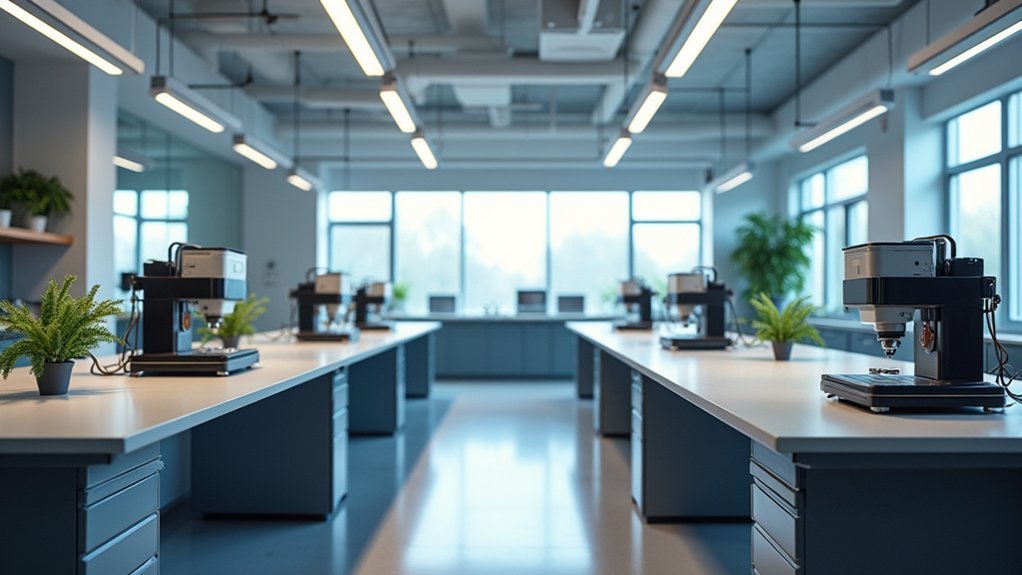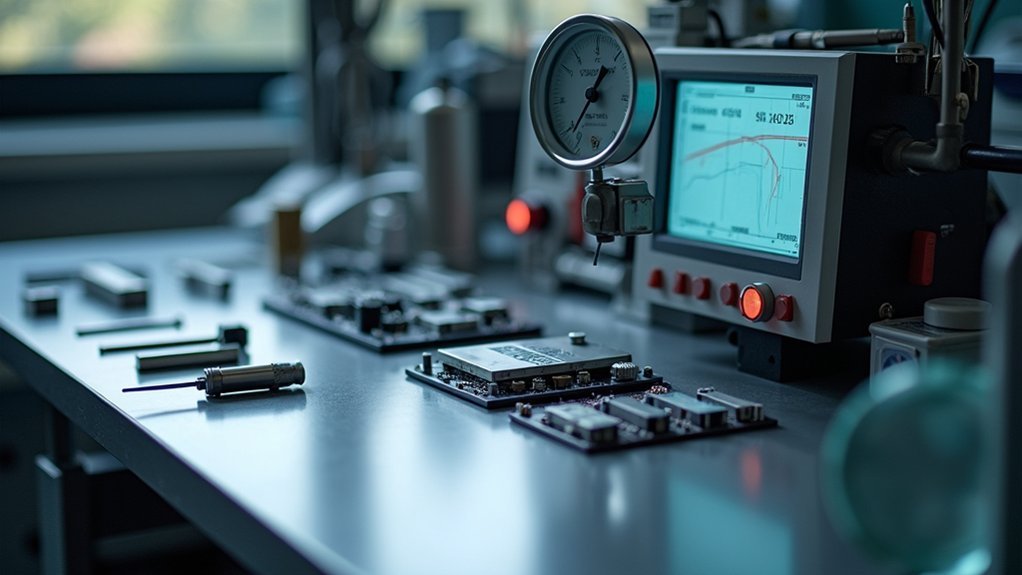To eliminate lab vibration issues, start with strategic equipment placement—position sensitive instruments on slab-on-grade foundations away from mechanical rooms and building facades. Next, implement appropriate vibration-damping solutions like rubber isolators, cork materials, or air tables based on your specific equipment needs. Finally, establish routine maintenance schedules that include motor balancing and regular frequency analysis. These three approaches will dramatically improve data integrity and instrument performance in your laboratory environment.
Strategic Equipment Placement to Minimize Environmental Vibrations

When setting up your laboratory, the strategic placement of equipment serves as your first line of defense against vibration issues. Position vibration-sensitive instruments like electron microscopes on slab-on-grade foundations rather than elevated floors, especially in steel structures where vibrations travel freely.
Strategic equipment placement prevents vibration problems before they start—always position sensitive instruments on solid foundations.
Keep your sensitive equipment far from mechanical rooms, elevators, and electrical panels that generate background noise. You’ll achieve better vibration control by placing instruments away from building facades, which are vulnerable to external disturbances like traffic and wind.
Install mechanical equipment on proper damping materials with 5-10 Hz resonant frequency for effective vibration isolation.
Don’t overlook layout planning early in your lab design process—you’ll save significant trouble by separating vibration sources from instruments that are sensitive to vibration.
Implementing Vibration-Damping Materials and Platforms
Even after ideal equipment placement, you’ll need effective damping solutions to eliminate remaining vibration issues in your laboratory. Select vibration-control systems based on your specific lab equipment weight and sensitivity requirements.
| Solution Type | Effective Range | Power Needed | Best Application |
|---|---|---|---|
| Rubber Isolators | 5-10 Hz | None | Mechanical equipment |
| Cork Materials | Low frequencies | None | General lab equipment |
| Passive Mechanical Tables | Down to 0.5 Hz | None | Precision instruments |
| Air Tables | Down to -1 Hz | Air/nitrogen source | Ultra-sensitive analytics |
For sensitive instruments, air tables provide superior vibration isolation requiring only a compressed gas source. Passive mechanical tables offer an excellent alternative without external power requirements, functioning similarly to car suspension systems. When selecting damping materials, consider both the equipment’s weight and performance needs to maintain data integrity.
Routine Maintenance and Calibration for Optimal Performance

Regular maintenance schedules represent your first line of defense against vibration-related performance issues in laboratory equipment. By consistently balancing motors and checking alignment, you’ll prevent excessive vibrations that degrade image resolution in sensitive instruments.
Don’t forget to verify that belts are properly tensioned during routine maintenance to minimize disruptions.
- Conduct frequency analysis quarterly to identify vibration sources, allowing you to target specific problem areas before they affect your results
- Install appropriate damping materials (with 5-10 Hz resonant frequency) under mechanical equipment to effectively absorb vibrations
- Implement scheduled calibration processes for sensitive instruments to account for shifts in baseline vibration levels
Remember that proactive maintenance isn’t just about fixing problems—it’s about maintaining the precision your lab work demands.
Frequently Asked Questions
How Do You Solve Vibration Problems?
You’ll solve vibration problems by placing equipment on slab-on-grade foundations, using pneumatic tables, adding rubber isolators, maintaining motors regularly, and separating vibration sources from sensitive areas. These methods minimize transmission and protect sensitive instruments.
What Cancels Out Vibration?
You’ll find vibrations are canceled by pneumatic tables, active electronic systems, passive mechanical isolators, rubber mounts, and strategic equipment placement on solid foundations. Each solution absorbs or counteracts disruptive movements in different frequency ranges.
What Are the Methods of Reducing Vibration?
You can reduce vibrations by using pneumatic tables, placing equipment on slab-on-grade foundations, employing rubber isolators, positioning mechanical equipment in dedicated cores, and maintaining motors regularly through balancing and tension adjustments.
What Is the Best Way to Dampen Vibrations?
You’ll need to choose based on your specific needs. For extreme sensitivity, use pneumatic tables or active isolation systems. For basic needs, rubber isolators or passive mechanical tables offer cost-effective dampening without requiring power sources.
In Summary
Remember, you don’t need to tolerate vibration problems in your lab. By strategically placing equipment, incorporating vibration-damping materials, and maintaining a regular calibration schedule, you’ll greatly improve your research outcomes. These three approaches aren’t just quick fixes—they’re investments in your lab’s precision and reliability. Implement them today, and you’ll wonder why you didn’t address these issues sooner.





Leave a Reply